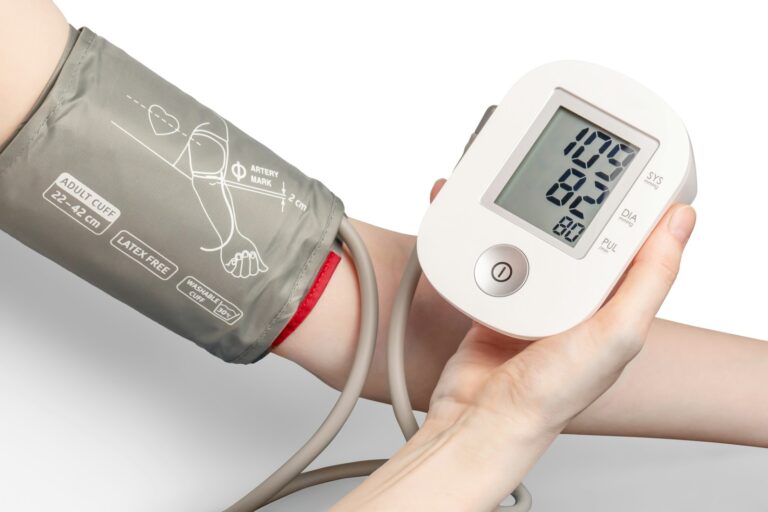Stress is unavoidable — bills, deadlines, family responsibilities, and the constant ping of notifications can keep your body on high alert. In small bursts, stress can be useful. But when it lingers, it can quietly raise your blood pressure and strain your heart. If you’ve ever felt your pulse quicken during a tense moment or noticed your numbers climb during a hectic week, you’ve already seen the stress–blood pressure link at work.
This guide explains how stress affects your cardiovascular system, the habits that make it worse, and the practical steps you can take to break the cycle. For more targeted strategies, explore our Blood Pressure Management hub and pair this with the lifestyle changes in 10 Everyday Habits That Help Lower Blood Pressure Naturally.
How Stress Raises Blood Pressure (What’s Going On Inside Your Body)
When you encounter stress, your body releases adrenaline and cortisol. These hormones are designed to help you react quickly — they increase heart rate, tighten blood vessels, and send more blood to your muscles. That’s helpful if you’re escaping danger, but not so great if you’re just answering emails.
- Adrenaline speeds up your heart to move blood faster.
- Cortisol keeps you in a heightened state and can increase sodium retention, subtly nudging blood pressure higher over time.
- Vessel constriction (narrower arteries) means the heart must push harder — and your numbers rise.
If this stress state becomes your “new normal,” those short-term spikes turn into a chronic pattern. That’s why stress management is a real, measurable part of blood pressure control.
Long-Term Effects: Why Chronic Stress Is Hard on Your Heart
Chronic stress doesn’t just make you feel tense — it reshapes routines and biology. Over time, it can:
- Keep your blood vessels chronically constricted, increasing resistance (and pressure).
- Promote inflammation that stiffens arteries.
- Disrupt sleep, appetite, and energy, which undermines healthy habits.
- Encourage coping behaviors (smoking, alcohol, sugary foods) that directly raise blood pressure.
The Hidden Stress Traps That Raise Your Numbers
It’s not just the stressor — it’s what we do about it. These common habits quietly push blood pressure higher:
- Relying on caffeine to “power through” (temporary spikes + sleep disruption).
- Comfort foods high in sugar and sodium (water retention + weight gain).
- Skipping workouts when you’re busy (lower resilience to stress).
- Late-night screen time (poor sleep quality = higher BP the next day).
If those sound familiar, you’re not alone. The fix isn’t perfection — it’s creating simple, repeatable alternatives.
Real-Life Scenario #1: The Weekend Spike
Sam works long hours and “unwinds” with salty takeout and two energy drinks while gaming. By Sunday night, Sam’s BP is 10–15 points higher than midweek.
What helped: Swapping energy drinks for green tea, choosing a lower-sodium takeout (grilled protein + vegetables), and adding a 20-minute walk after dinner. The next month, Sam’s weekend readings dropped noticeably.
How to Break the Stress–Blood Pressure Cycle
These strategies calm your nervous system, improve circulation, and build resilience so spikes are less intense and less frequent.
1) Master a 60-Second Breathing Reset (Do It Anywhere)
When stress hits, your breath gets shallow. A quick reset lowers sympathetic (fight-or-flight) drive:
- Inhale through your nose for 4 counts.
- Hold for 2 counts.
- Exhale slowly through your mouth for 6 counts.
- Repeat for 60–90 seconds.
Use this before a meeting, after a difficult call, or whenever you feel pressure rising.
2) Move Your Body Daily (Short Bouts Count)
Exercise lowers resting blood pressure and burns off stress hormones. You don’t need an hour — three 10-minute bouts (brisk walks, bodyweight circuits, or stair climbs) can be as effective as one longer session.
For sustainable fitness ideas, browse Everyday Health & Wellness.
3) Protect Your Sleep Window
Quality sleep restores hormonal balance and lowers blood pressure. Aim for 7–9 hours with a consistent schedule. Try a 30-minute “wind-down” routine: dim lights, stretch, read, or journal. Avoid screens the last hour.
4) Build a Stress-Resistant Plate
Stabilize energy (and mood) with balanced meals: protein + fiber + healthy fats. This reduces sugar crashes that can intensify stress. Keep potassium-rich foods (spinach, beans, avocado) in rotation to counter sodium and support vessel relaxation.
For smart swaps, read Foods That Can Raise Your Blood Pressure (and What to Eat Instead).
5) Limit Caffeine & Alcohol (Without Feeling Deprived)
Caffeine can raise BP short-term and disrupt sleep; alcohol may lower inhibitions and lead to salty snacking. Try a 2-week “taper”: halve caffeine after noon; reserve alcohol for one planned occasion weekly.
Need beverage ideas that won’t sabotage your numbers? See Hydration & Heart Health and Best Beverages for Heart Health.
6) Create Micro-Boundaries for a Calmer Day
Stress often comes from friction — too many inputs, too few pauses. Institute “micro-boundaries”:
- Email checks at set times (e.g., 10am / 2pm / 4pm).
- 5-minute screen-free break every 60–90 minutes.
- “Hard stop” evening time to protect sleep.
7) Try an Evening Unwind Ritual (10–15 Minutes)
Choose a simple ritual you enjoy — stretching, a warm shower, breathing practice, or journaling. Rituals teach your nervous system when to downshift, helping overnight blood pressure normalize.
Real-Life Scenario #2: The Caregiver Crunch
Leila cares for an elderly parent and juggles two jobs. She noticed headaches and higher BP on home readings.
What helped: A 10-minute morning walk, batch-cooking low-sodium meals on Sundays, and a nightly 5-minute breathing routine. After 6 weeks, Leila’s average readings improved and the headaches decreased.
Track What Triggers You (and What Calms You)
Awareness is powerful. For one week, jot down:
- Triggers: Times, tasks, or people that raise tension.
- Body cues: Tight shoulders, racing thoughts, shallow breathing.
- Resets that worked: Walk, water, stretch, call a friend, micro-nap.
Pair this with consistent home BP readings (morning and evening, seated, arm supported). See our upcoming Beginner’s Guide to Monitoring Your Blood Pressure at Home for setup tips.
Build a 7-Day Stress-Lowering Plan (Repeat Weekly)
- Mon: 20-minute walk + 60-second breathing reset before lunch and dinner.
- Tue: Strength circuit (15 minutes) + caffeine cutoff at noon.
- Wed: Screen-free evening (read or stretch for 20 minutes).
- Thu: Meal prep a low-sodium dinner; add potassium-rich sides.
- Fri: Social connection (call or walk with a friend).
- Sat: Longer outdoor activity (40–60 minutes) + early bedtime.
- Sun: Plan the week; set micro-boundaries for email/notifications.
This isn’t about perfection — it’s about a repeatable rhythm that keeps stress in check and supports healthier numbers.
Hydration Helps (But Skip the Sugar)
Dehydration thickens blood slightly, making your heart work harder. Keep a water bottle within arm’s reach and sip regularly. Avoid sugary “energy” drinks that can drive spikes. For sugar-smart hydration, see How to Stay Hydrated Without Overloading on Sugar.
When to Talk to Your Doctor
Stress management complements — not replaces — medical care. Contact a healthcare professional if:
- Your average home readings are consistently elevated (e.g., ≥130/80).
- You experience chest pain, severe headaches, or shortness of breath.
- You’re starting, stopping, or changing medications or supplements.
If you’re already on BP medication, these lifestyle tools can make your treatment more effective. Monitor regularly to see how your numbers respond.
Real-Life Scenario #3: The Busy Parent Reboot
Arman noticed his BP readings were higher after late-night work sprints. He also skipped workouts and leaned on extra coffee.
What helped: Setting a 10:30pm screen cutoff, swapping the second afternoon coffee for herbal tea, and adding a 15-minute kettlebell routine three mornings a week. Within a month, Arman’s morning systolic number dropped 5–8 points.
Final Thoughts
Stress and high blood pressure are linked — but that doesn’t mean you’re stuck with higher numbers. When you reduce the intensity and frequency of stress responses, your blood vessels relax, your heart works less, and your readings improve. Start with one or two changes: a daily walk, a 60-second breathing reset before meals, or a consistent bedtime. Then layer in nutrition and hydration upgrades.
Keep building from there. For next steps, explore Blood Pressure Management, stock up on helpful tools in All Products, and round out your routine with the habit playbook in 10 Everyday Habits That Help Lower Blood Pressure Naturally.





